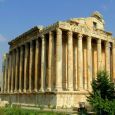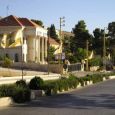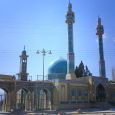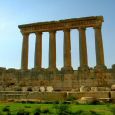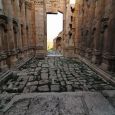Baalbek
Advertisement
By Air
The closest aiport for Baalbek is Beirut Rafik Hariri International Airport (IATA: BEY), is the country's only international airport and the hub of Lebanon's national carrier, Middle East Airlines (MEA).Most international airlines have daily flights between Beirut and the major European capitals.The airport is located 7km south of Beirut, and is roughly a 10 to 15 minute drive from the city center.
By Bus
Buses to Baalbek from Beirut leave the Cola intersection frequently and cost LL5,000.During the summer season daily tours are available from Beirut to Baalbeck from most major hotels; tour operator Nakhal has a guided coach tour several days a week for USD$70.The trip takes about two hours each way.It is possible to travel from Homs in Syria to Baalbek by bus.Buses leave from the Karnak or Luxury coach stations in Homs and cross into Lebanon at al-Qa'a, arriving soon thereafter at Baalbek.Cost is about USD$10.
Temple of Bacchus
was one of the three main temples at a large complex in Classical Antiquity, at Baalbek in Lebanon. The temple was dedicated to Bacchus (also known as Dionysus), the Roman god of wine, but was traditionally referred to by Neoclassical visitors as the "Temple of the Sun". It is considered one of the best preserved Roman temples in the world. It is larger than the Parthenon in Greece, though much less famous.The temple was commissioned by Roman Emperor Antoninus Pius and designed by an unknown architect c. 150 AD, and built close to the courtyard in front of the larger temple of Jupiter-Baal. When the temple complex fell into disrepair, the Temple of Bacchus was protected by the rubble of the rest of the site's ruins. The temple is 66m long, 35m wide, and 31m high. Its walls are adorned by forty-two unfluted Corinthian columns, nineteen of which remain upright in position standing 19 m high. The columns support a richly carved entablature. Inside, the cella is decorated with Corinthian half-columns flanking two levels of niches on each side, containing scenes from the birth and life of Bacchus. The adyton (inner shrine) stands above a flight of steps.
Sheikh Abdullah Hill Quarry
the world's largest cut stone at the quarry on Sheikh Abdullah Hill, you'll undoubtedly hear the tale of Baalbek native Abdul Nabi Al-Afi, who saved it from life at the bottom of a rubbish dump. Measuring 21.5m by 4m by 4.5m, lying on its side, locals call this stone Hajar al-Hubla (Stone of the Pregnant Woman), and local folklore has it that women can touch the stone to increase their fertility.ither way, for many impoverished people in the Bekaa Valley, southern Lebanon and south of Beirut, Hezbollah has proved a vital lifeline, offering health, security and education where there is none on offer through other channels.
Temple of Jupiter
was built on an immense substructure over 90m long, and was approached by another monumental staircase that rose high above the surrounding buildings. It consisted of a cella in which the statue of the god was housed and a surrounding portico of 10 columns along the façade and 19 columns along the side, making for 54 columns in all. These columns are the largest in the world - 22.9m high with a girth of 2.2m.Today only six of these remain standing with the architrave still in position. It was thought in the old days that Baalbek had been constructed by giants and a quick look over the side of the temple to the foundation stones beneath reveals some of the largest building blocks to be found anywhere on earth. One of these megalithic blocks measures 19.5m by 4.3m and is estimated to weigh over 1000 tonnes - how it was moved and positioned so precisely remains a mystery.
Great Mosque
To the east of the propylaea stands the ruined Umayyad or Great Mosque, which was built from the stones of the temples using many styles of columns and capitals.Lebanon's only Umayyad ruin, outside Aanjar, it was built between the 7th and 8th centuries.There is an ablution fountain surrounded by four columns in the centre of the courtyard. On the right, immediately after the entrance, are rows of arched colonnades with Roman columns and capitals, clearly taken from the temple complex.At the northwestern corner are the ruins of a great octagonal minaret on a square base.
Ras al-Ain Spring
To the southeast of Baalbek's centre is the source of the Ras al-Ain Spring.The area has pleasant, shady parks along the spring and is the site of occasional festivities with horses and camels and side stalls.At the head of the spring is a ruined early mosque, which at some point was thought to be the Temple of Neptune.
Information not available


